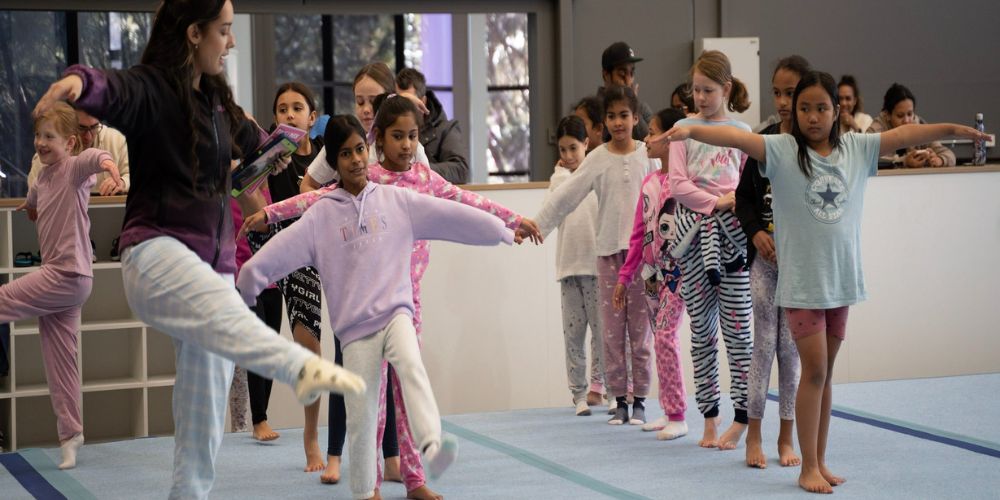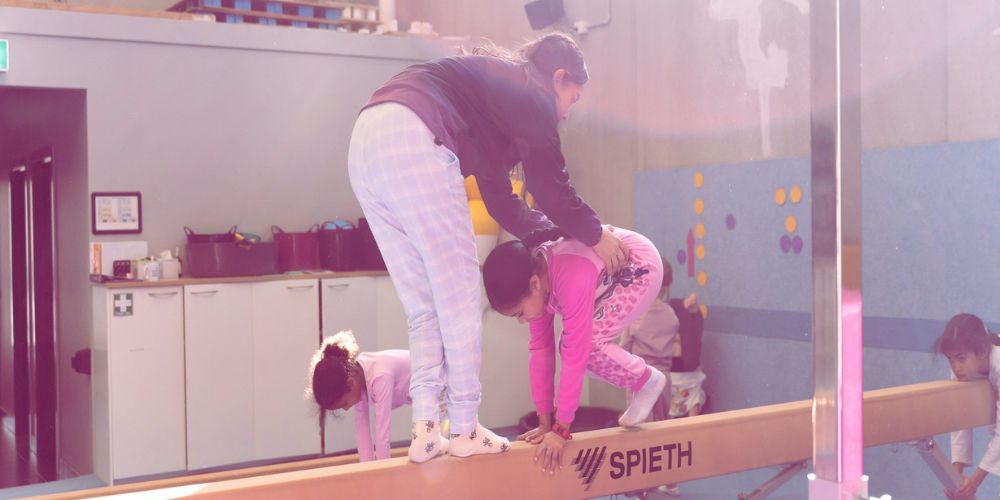Injuries, just like in any sport, are inevitable. However, the risk of getting injured is higher in gymnastics, where leaps, flips, and twists are part of the routine. I've been training hundreds of gymnasts for years now, but I can't help but feel a deep sense of responsibility for their safety and well-being. Every time a gymnast steps onto the mat or approaches an apparatus, I am acutely aware of their potential risks.
Despite my experience and expertise, I know that accidents can happen instantly, so I'm constantly striving to enhance safety measures and instil proper techniques in my athletes. It's a constant balancing act between pushing them to reach their full potential and ensuring they stay injury-free. As a trainer, my greatest satisfaction comes from seeing my gymnasts progress and succeed, knowing that I've played a role in keeping them safe.
Throughout my years of coaching, I've learned that prevention is key. It's not just about perfecting those routines; it's also about understanding your body and its limits.
In this blog, we'll delve into the common injuries gymnasts face, how they occur, and, most importantly, how to prevent them. So, whether you're a budding gymnast or a seasoned pro, let's flip into action and learn to stay safe while soaring through the air!
How Common is Injury AMong Gymnasts?
Injuries are an unfortunate reality in the world of gymnastics. From sprained ankles to more serious fractures, gymnasts can face a variety of injuries during their training and competitions. But just how common are these injuries?
Injuries occur but are not as rampant as some may fear. When proper training techniques and safety measures are in place, the risk of injury can be significantly reduced.
Based on statistics discussed by Gitnux:
- About 40% of all gymnastics injuries involve the lower extremities, while 30% involve the upper extremities.
- Gymnastics has the highest injury rate among female athletes – 12.3 injuries per 100,000 participants.
- Approximately 14% of all gymnastics injuries result in fractures.
- Girls are more than twice as likely to sustain an injury compared to boys in gymnastics.
- Gymnastics injury rates in training are 2.24 per 1000 athlete exposures.
- The overall injury rate in men's gymnastics is 17.3 per 1000 athlete exposures.
- 47% of gymnasts have reported hand injuries, with hand rips being the most common.
- Female gymnasts suffer from anterior cruciate ligament (ACL) injuries at a rate of 4.71 per 100,000 athlete exposures.
- Gymnasts have a 7.4% annual prevalence of lower back pain.
- A study found that 42% of gymnasts have experienced stress fractures in their spines.
Most Common Injuries During Gymnastics
While gymnasts are known for their strength, flexibility, and agility, the nature of the sport also exposes them to certain risks. Let's take a closer look at some of the most common injuries faced by gymnasts:
Sprained Ankles
The most prevalent injury in gymnastics is sprained ankles, which occur when a gymnast lands awkwardly or twists their ankle during a routine. This can happen on any apparatus but is particularly common on the floor exercise and vault.
Wrist Injuries
Gymnasts put significant weight on their wrists, especially during skills like handstands and tumbling passes. As a result, wrist sprains and strains are common, along with overuse injuries like tendonitis.
Knee Injuries
The knees endure much stress in gymnastics, particularly during landings and jumps. Common knee injuries include ligament sprains, meniscus tears, and patellar tendonitis.
Back Injuries
The repetitive nature of gymnastics movements, combined with the need for extreme flexibility, can strain the lower back. Gymnasts are susceptible to conditions like spondylolysis (stress fractures in the vertebrae) and muscle strains.
Fractures
While less common, fractures can occur in gymnastics, especially in high-impact events like the vault or floor exercise. Fractures can affect various bones, including the wrists, ankles, and spine.
What Usually Causes Injuries Among Gymnasts?
Here are some common causes we observed during training that would often cause injuries among our athletes:
- Improper Technique: Performing skills with incorrect form or technique increases the risk of injury. This could involve errors in body positioning, timing, or execution during gymnastics manoeuvres.
- Overuse: Repetitive stress on the body from practising the same skills or routines excessively can lead to overuse injuries such as stress fractures, tendonitis, or muscle strains.
- Lack of Conditioning: Insufficient strength, flexibility, or endurance can make gymnasts more susceptible to injuries. Proper conditioning programs tailored to the demands of gymnastics can help prevent muscle imbalances and weaknesses that may contribute to injury.
- Equipment Malfunction or Failure: Faulty or improperly maintained equipment, such as uneven bars, balance beams, or landing mats, can pose serious injury risks if they malfunction or fail during use.
- Fatigue or Mental Distraction: Physical and mental fatigue can impair a gymnast's coordination, judgment, and concentration, increasing the likelihood of accidents or falls.
- Pushing Beyond Limits: Attempting skills or routines that exceed a gymnast's current skill level or physical capabilities can lead to injuries. Progression should be gradual and guided by proper coaching to ensure safety.
Famous Gymnastics Injuries
Throughout the history of gymnastics, several notable injuries have captured the attention of fans and athletes alike. While these incidents are often unfortunate, they remind us of the risks inherent in the sport and the resilience of gymnasts in overcoming adversity. Here are a few famous gymnastics injuries that have left a lasting impact:
Kerri Strug's Vault at the 1996 Olympics
Perhaps one of the most iconic moments in gymnastics history, Kerri Strug's vault during the team competition at the 1996 Atlanta Olympics is etched into the memory of sports fans worldwide. Despite injuring her ankle during her first vault attempt, Strug courageously performed a second vault, securing the gold medal for Team USA. Her determination in the face of injury symbolised perseverance and dedication.
Elena Mukhina's Tragic Accident
In 1979, Soviet gymnast Elena Mukhina suffered a devastating injury while practising a dangerous tumbling pass on the floor exercise. The accident left her paralysed from the waist down, ending her gymnastics career and casting a sad light on the risks involved in the pursuit of perfection.
Beth Tweddle's Spinal Injury
British gymnast Beth Tweddle experienced a serious injury during rehearsals for the reality TV show "The Jump" in 2016. She fractured two vertebrae in her neck while performing a ski jump, leading to emergency surgery. Tweddle's injury highlighted the importance of proper safety measures, even in non-competitive settings.
Simone Biles' Vault Landing at the 2021 World Championships
During the vault final at the 2021 World Championships, Simone Biles experienced a rare error, landing awkwardly and stumbling off the mat. While she avoided serious injury, the incident served as a reminder that even the most skilled gymnasts are not immune to mistakes and the potential consequences.
Nadia Comăneci's Balance Beam Fall
During a competition in 1980, Romanian gymnast Nadia Comăneci, renowned for her perfection in gymnastics, suffered a rare fall from the balance beam. The fall shocked fans and competitors alike, serving as a reminder that even the most accomplished athletes can experience setbacks.
Olga Korbut's Uneven Bars Mishap
In 1976, Soviet gymnast Olga Korbut, known for her innovative and daring routines, experienced a fall during her uneven bars routine at the Montreal Olympics. The fall cost her a chance at winning a medal in the event, underscoring the fine line between success and disappointment in gymnastics.
How Can We Keep Our Gymnast Away from Injuries?
NBC News ranks gymnastics among riskiest sports.
That is why ensuring the safety and well-being of our athletes is our primary priority as gymnastics trainers. Although injuries are an unpleasant part of the sport, we can use several strategies to reduce the danger and maintain the health and well-being of our gymnasts.
Proper Warm-Up and Stretching
We ensure that gymnasts perform a complete warm-up routine before each training session and competition. Improving muscle blood flow helps them become more pliable and less prone to damage. Dynamic stretches and exercises tailored to gymnastics techniques can help the body get ready for the demands of training.
Focus on Technique
Emphasising proper technique and form is essential in gymnastics. Ensuring that gymnasts master the fundamentals of each skill before progressing to more advanced movements can help reduce the risk of injury. Regular feedback and corrections during training sessions can help reinforce good habits and prevent harmful habits from developing.
Gradual Skill Progression
Progressing too quickly to advanced skills without adequate preparation can increase the risk of injury. Implementing a structured training plan that gradually builds upon foundational skills allows gymnasts to safely develop strength, coordination, and confidence. Additionally, incorporating rest days and active recovery periods into training schedules can help prevent overuse injuries.
Adequate Equipment Maintenance
Regularly inspecting and maintaining gymnastics equipment, such as mats, bars, and beams, is essential for ensuring a safe training environment. Checking for signs of wear and tear, securing equipment properly, and providing sufficient padding can help minimise the risk of accidents and injuries during practice sessions.
Supervision and Spotting
Having qualified coaches and spotters present during training sessions is crucial for providing guidance, support, and assistance when needed. Coaches can help identify potential hazards, correct technique errors, and intervene to prevent accidents before they occur. Additionally, teaching gymnasts how to fall safely and spot each other during skills can empower them to take ownership of their safety.
Cross-Training and Conditioning
Incorporating cross-training activities and strength conditioning exercises into gymnasts' training regimens can help improve overall fitness, stability, and resilience. Building strength in key muscle groups, such as the core, shoulders, and legs, can enhance performance and reduce the risk of injury during high-impact skills.
Frequently Asked Questions
Are gymnastics injuries usually minor or severe?
Gymnastics injuries can vary in severity, ranging from minor strains and sprains to more serious fractures or dislocations, depending on the nature of the activity and the athlete's experience level.
What should gymnasts do if they get injured?
If a gymnast sustains an injury, they must prioritize their health and well-being by seeking immediate medical attention. As their trainer,we strictly advise them to follow the guidance of their healthcare provider carefully and to communicate openly about their injury status and recovery progress.
Can beginners in gymnastics expect a higher risk of injury than experienced gymnasts?
Beginners in gymnastics may face a higher risk of injury compared to experienced gymnasts due to their unfamiliarity with proper technique and conditioning. However, with proper coaching, progression, and adherence to safety guidelines, beginners can minimize their risk of injury over time.
Can overtraining contribute to injuries in gymnastics?
Overtraining is a common concern in gymnastics and can indeed contribute to injuries. I emphasize balancing training intensity with adequate rest and recovery as a trainer. By incorporating cross-training activities, monitoring workload, and promoting proper recovery strategies, I aim to help gymnasts prevent overuse injuries and maintain peak performance safely.
Conclusion
While gymnastics is demanding and potentially risky, injuries can be minimized with the right precautions and approach. As gymnastics trainers, coaches, parents, and athletes, it's crucial to prioritize safety above all else.
Focusing on proper technique, gradual progression, adequate conditioning, and maintaining equipment can create a safer environment for gymnasts to thrive in. Remember, injury prevention is a team effort, and by working together, we can ensure that gymnasts can pursue their passion for the sport safely and confidently. Stay focused and diligent, and prioritize your well-being above all else.




